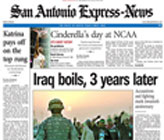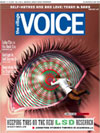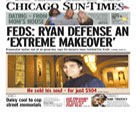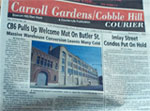With Rupert Murdoch’s $5 billion purchase of Dow Jones now approved by the board, the question focuses even more on how he might operate the company’s flagship Wall Street Journal. Those scrutinizing Murdoch’s U.S. newspaper holdings for clues to his stewardship of the Journal have frequently cited his in-your-face conservative New York Post tabloid as Exhibit A, and his ownership of papers in Europe as Exhibit B, from the Times of London to the tabloid Sun, complete with topless Page 3 girls.
But what is Murdoch’s record in the American newspaper business?
American newspapering is far different than in Europe. In England, the bulk of a newspaper’s revenues come from circulation, and a tabloid strategy can be highly profitable. American newspapers, in contrast, generate roughly 80% of their revenue from advertising. Circulation, if its not attractive to advertisers, can prove frankly counterproductive. Some American newspapers have even scaled back on “unprofitable” circulation to save money.
Although Murdoch’s American newspaper holdings now include only the Post and community papers in Brooklyn and Queens, he once published dailies in San Antonio, Chicago, and Boston as well a supermarket tab and a liberal alternative weekly. In the 1980s, he appeared to be pursuing a strategy of buying tabloids in several major American markets, a venture abandoned eventually in favor of his vision to build a fourth TV network.
Murdoch’s history with U.S. newspapers would not, on its face, seem to indicate a single clear corporate strategy. In several instances, he bought papers at the last minute before extinction at remainder prices. In the end, Murdoch has not stuck with any American newspaper other than the New York Post, which he still operates at a substantial loss. He did, in some cases, reap sales profits that were been plowed into other sectors of his media empire. A number of his papers were sold after he ran afoul of the FCC’s ban on cross-ownership that prevents one company from owning a TV station and newspaper in the same market, a sign that when pushed, Murdoch has put more of his passion into American television than American print.
Here’s a chronological snapshot of Murdoch’s history of U.S. print holdings.
Newspapers:

San Antonio Express and the San Antonio News: Purchased: In 1973 for $19 million Merged: In 1984 Sold: As Express-News, in 1993 for $185 million Bottom line: The combined paper that Murdoch assembled came to dominate the San Antonio market and pushed its competitor out of business.
On Murdoch’s initial foray into the world of U.S .print media, he bought these two papers in south Texas. He merged the two in 1984 in large part to combine the circulation to a higher number. News Corp sold the paper in 1993 to Hearst, owner of the local competition, the San Antonio Light (After the deal, Hearst folded the Light). An Express-News story on that sale reported that News Corp was still struggling financially from 1989 debt restructuring and needed cash.

The National Star: Launched: By News Corp. in 1974 for $9 million Sold: In 1990 for $400 million Bottom line: By the early 1980s the Star was recording an annual profit of about $12 million, according to at least one analysis.
Murdoch created this weekly supermarket tabloid as competition for the National Enquirer. Based in New York, many copies were printed on his San Antonio presses. A version of the tabloid was inserted into Murdoch’s San Antonio newspapers as a Sunday supplement. By the early 1980s, the Star (National was dropped from the name) was almost even in circulation with the National Enquirer, at close to 4 million. The Enquirer’s parent company, GP Group, purchased the Star in 1990.

New York Post Purchased: In 1976 for $30 million Sold: In 1988 for $37.6 million Re-purchased: In 1993 for $25 million Bottom line: Circulation has grown, but the paper, often described as a guilty second read for upscale Manhattanites, is a perennial money loser.
Murdoch originally bought this New York tabloid in 1976 from long-time owner Dorothy Schiff, who had made it arguably the most liberal newspaper in the country. The editorial slant shifted under Murdoch, but ultimately his TV interests conflicted with the Post’s ownership. FCC rules barred one company from owning a TV station and newspaper in the same city and Murdoch had purchased local TV station WNYW. So he sold the paper.
In 1993, with the Post apparently on the brink of shutting down, Murdoch offered to buy it back if the FCC granted him a waiver. Several New York politicians fought for Murdoch, including then Governor Mario Cuomo who was often skewered on its editorial pages. A frothy mix of gossip, grit, and conservative ideology, the paper, with a current circulation of about 690,000 is estimated to lose millions each year, so many that it seems unlikely most publicly traded corporations would justify sustaining it. (A 2005 Business Week story put that number between $15 and $30 million a year.) It is the one U.S. daily Murdoch currently owns.

Village Voice Purchased: In 1977, along with New York magazine and New West magazine for $7.6 million Sold: In 1985 for $55 million Bottom line: The paper enjoyed an increase in advertising and profitability under Murdoch, according to a New York Times story at the time of the sale.
While the Post might have tilted rightward with Murdoch, The Voice—the Manhattan weekly that was the granddaddy of the nation’s liberal alternative press—remained relatively free of editorial interference from it new owner. According to the Voice’s own account, Murdoch reportedly once wanted a reporter fired, but backed off when the editor refused. The sale of the paper helped free up cash that bankrolled Murdoch’s launch of the Fox broadcast network in 1986.

Boston Herald American Purchased: In 1982 for $1 million and possible future considerations Sold: In 1994 for a reported $10-15 million, according to Boston Globe accounts Bottom Line: Murdoch rescued an otherwise doomed paper. The man he sold it to, Pat Purcell, has said that the Herald started making money in the mid-1980’s but had unprofitable years in the early 90’s.
Murdoch bought the struggling tabloid, later renamed the Boston Herald, at a rock bottom price from the Hearst Corporation. (The famous headline announcing the paper’s sale to Murdoch read: “You Bet We’re Alive!”) In 1994, he sold the paper to his longtime employee and colleague, Pat Purcell, after the FCC’s cross-ownership rule prevented him from owning both the Herald and Boston TV station WFXT.

Chicago Sun-Times Purchased: In 1983 for $90 million Sold: In 1986 for $145 million Bottom Line: The tab saw an increase in profitability even as circulation fell thanks in large part to cost-cutting.
The biggest acquisition of his American tabloid period, Murdoch came to Chicago to buy the Sun-Times, a scrappy underdog in a market dominated by the Chicago Tribune. Under his ownership, the paper’s editorial pages moved rightward. But according to at least one estimate, he increased annual profits three-fold—from $3 million to $9 million—before selling because of cross-ownership issues after purchasing local TV station WFLD.

TimesLedger and Courier-Life Group Newspapers Purchased: In 2006 for $16 million Bottom Line: It’s too early to judge.
It may not have attracted much fanfare, but Murdoch recently bought these chains, a total of 28 community papers in Brooklyn and Queens. They may not be the Village Voice or the Post, but the papers have more than 100,000 combined readers in those boroughs. A Dow Jones purchase by Murdoch would add more weekly papers to his stable since the company’s Ottaway subsidiary publishes more than a dozen weeklies. In general, smaller local papers have been less susceptible to some of the newspapers industry’s recent circulation and revenue ills than larger metro dailies.
Note: The timeline dates and figures included in this summary were gathered from a variety of sources including newspaper articles, corporate statements and company histories.




